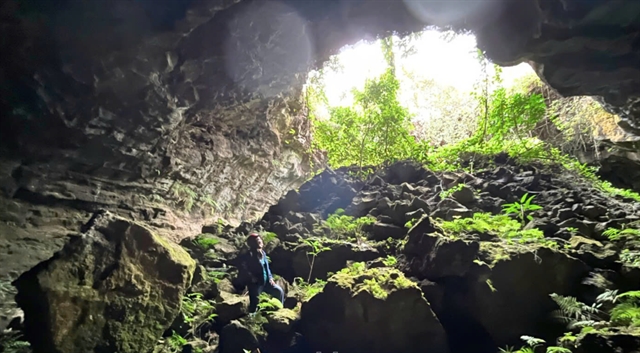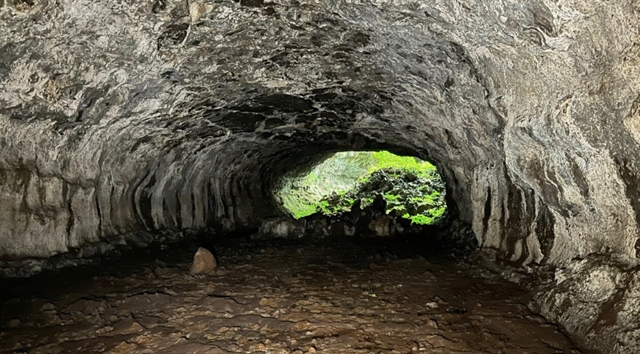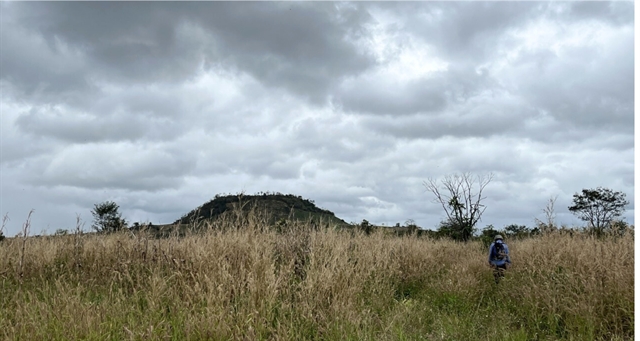The cave located in the north east, about 1,800m from the Nâm Blang crater, has been assessed as quite stable and solid, opening it up for local tourism development.

The new cave is located in the northeast, about 1,800m from the Nâm Blang crater in the Central Highlands province of Đắk Nông. Photos daknong.gov.vn
ĐẮK NÔNG A newly discovered lava cave in the Central Highlands province of Đắk Nông has firmly demonstrated the province's position on the world geological heritage map, experts and authority have said.
The Centre for Investment Promotion, Enterprise Support and Management of Đắk Nông Geopark said a group of experts discovered the completely new cave in the Đắk Nông UNESCO Global Geopark Site, after comparing with records of previously known caves.
The group included La Thế Phúc, PhD, deputy director of the Institute of Applied Geology and Minerals Research, and volcanic cave expert Lương Thị Tuất, according to the centre.
The new cave discovery was announced late last month by the centre, following a ceremony held by the province to celebrate the second time Đắk Nông had received UNESCO global geopark recognition.
It has thrown an 'important spotlight' in research and discovery works of the local experts.
The cave, located, about 1,800m from the Nâm Blang crater, is quite wide with a flat floor and a sturdy ceiling.

The new cave is quite wide with a flat floor and sturdy ceiling.
Preliminary tests have shown that the structure of the cave is quite stable and solid, opening it to become part of local tourism development, the experts said.
This discovery not only affirms the continuous research efforts of scientists, but also motivates Đắk Nông to continue promoting its tourism potential, attracting domestic and international investors and tourists.
This is a clear demonstration of the province's position on the world geological heritage map, contributing to promoting sustainable socio-economic development associated with the brand "Đắk Nông UNESCO Global Geopark - Land of Melodies", authority has said.
Đắk Nông celebrated the second conferment of the UNESCO Global Geopark title for its geopark at a ceremony organised by the provincial People’s Committee [provincial administration] on December 26.
Speaking at the ceremony, Chairman of the provincial People’s Committee Hồ Văn Mười said the Đắk Nông UNESCO Global Geopark holds a critical role in the province’s socio-economic development strategy.
He said that the local authorities prioritise tourism development by promoting the park’s natural advantages, cultural values and unique ecosystems. The work has been identified as one of the three key pillars of the provincial economy.

The structure of the cave has been initially assessed and found to be quite stable and solid, opening up great potential for local tourism development.
In a congratulatory video sent to the event, Guy Martini, general secretary of the Global Geopark Network and chairman of the UNESCO Global Geopark Council, lauded Đắk Nông's efforts, and affirmed UNESCO’s commitment to supporting the province in leveraging the title’s values, turning the heritage into a significant resource for sustainable development.
In July last year, the UNESCO Global Geopark designation of the Đắk Nông Geopark was validated for another four years from 2024 to 2027.
The designation recognised the province’s efforts to protect and promote the values of the geopark and offers an opportunity to attract resources for sustainable development.
The Đắk Nông Geopark was recognised by UNESCO as a global geopark in July 2020, becoming the third geopark in Việt Nam, after Đồng Văn Karst Plateau Geopark in Hà Giang, and the Non Nước Cao Bằng Geopark in Cao Bằng.
Covering an area of over 4,700sq.km, spanning six districts and towns, an equivalent to two-fifths of Đắk Nông’s total area, the geopark is known for its biodiversity, rich tropical forest ecosystem and traces of prehistoric humans.
It boasts approximately 65 geological and geomorphological heritage sites, including nearly 50 caves with a total length exceeding 10,000 metres, volcanic craters, waterfalls and other natural features. Among these, seven sites have been recognised for their international significance. VNS